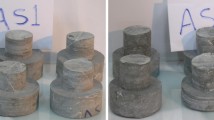Abstract
Basic friction angles of the Paleozoic carbonate rocks of Kananaskis Country, west of Calgary, Canada were determined on a tilting table to range from 21.5o to 41.3o. The basic friction angles of carbonate rocks with impurity contents under 10% increase with calcite content and grain size. Clay minerals reduce basic friction angles in carbonate rocks with impurity contents over 10%. Sliding angles from repeated tests decrease with displacements for dolostones but not for limestones. The friction angles of highly polished surfaces are 7.5 to 7.9o for dolostones and 11.8 to 13.0o for limestones, a difference attributed to the frictional properties of the minerals.
Résumé
On a mesuré les angles de frottement des roches Paléozoiques carbonatées dans le pays de Kananaskis, à l'ouest de Calgary, au Canada sur une table inclinée dans un intervalle de 21.5 à 41.3o. Les angles de frottement des roches carbonatées qui contiennent moins de 10% d'impuretés, augmentent en fonction de la teneur en calcite et de la dimension des grains. Les minéraux argileux, en lubrifiant les surfaces de glissement, réduisent les angles de frottement des roches carbonatées qui contiennent plus de 10% d'impuretés. En faisant des essais successives, les angles de glissement des dolomies diminuent en fonction des déplacements, ce qui n'est pas le cas pour les calcaires. Les angles de frottement des surfaces extrêmement lisses sont de 7.5 à 7.9o pour les dolomies et de 11.8 à 13.0o pour les calcaires. On attribue cette différence aux caractéristiques de surface des minéraux.
Similar content being viewed by others
References
BIELENSTEIN H. U., Price, R. A. and Jones, P. B., 1971: Geology of the SeebeKananaskis Area, Map in Halladay, I A. R. and Mathewson, D. H., A Guide to the Geology of the Eastern Cordilera along the Trans Canada Highway between Calgary, Alberta and Revelstoke, British Columbia, Alberta Society of Petroleum Geologists, Calgary, 94 p.
BISHOP A. W., 1973: The Stability of Tips and Spoil Heaps, Quarterly Journal of Engineering Geology, Vol. 6, pp. 335–376.
BRUCE I. G., 1978: The Field Estimation of shear Strength on Rock Discontinuities, Ph. D. Thesis, University of Alberta, Edmonton, Alberta, Canada, 309 p.
BRUCE I. G., CRUDEN, D. M. and EATON, T. M. 1989: The Use of A Tilting Table to Determine the Basic Friction Angle of Hard Rock Samples, Canadian Geotechnical Journal, in press.
COULSON J. H., 1970: The Effects of Surface Roughness on the shear strengths of joints, Ph.D. Thesis, University of Illinois, Urbana, Illinois, USA.
COULSON J. H., 1972: Shear Strength of Flat Surfaces in Rock, Proceedings, 13th Symposium on Rock Mechanics, pp. 77–105.
CRUDEN, D. M., 1985: Rockslope Movements in the Canadian Cordillera, Canadian Geotechnical Journal, 22, pp. 528–540.
CRUDEN D. M. and EATON, T. M., 1987: Reconnaissance of rockslide hazards in Kananaskis Country, Alberta, The Canadian Geotechnical Journal, 24, pp. 414–429.
CRUDEN D. M., EATON T. M. and HU X. Q., 1988: Rockslide Risk in Kananaskis Country, Alberta, Canada, 5th International Symposium on Landslides, Lausanne, Switzerland, pp. 1147–1152.
EATON T. M., 1986: Reconnaissance of Rockslide Hazards in Kananaskis Country, M.Sc. Thesis. University of Alberta, Edmonton, Canada, 291p.
FOOKES P. G., and HIGGINBOTTOM I. E., 1975: The Classification and Description of Near-shore Carbonate sediments for Engineering Purposes. Geotechnique, 25, pp. 406–411.
HILLEBRAND W. F., LUNDELL G. E. F., BRIGHT H. A., and HOFFMAN J. I., 1953: Applied Inorganic Analysis, Wiley, New York, 1034 p.
HORN H. M. and DEERE D. U., 1962: Frictional Characteristics of Minerals, Geotechnique 12, pp. 319–335.
LEIGHTON M. W. and PENDEXTER C., 1962: Carbonate Rock Types, In Classification of Carbonate Rocks, Asymposium, Edited by William E. Ham American Association of Petroleum Geologists, Tulsa, pp. 33–61.
Mining Research and Development Establishment, 1977: NCB Cone Indenter, MRDE Handbook, 5, 12p.
PATTON F. D., 1966: Multiple Modes of Shear Failure in Rock, Proceedings Ist International Congress of Rock Mechanics, Lisbon, 1, pp. 509–513.
SWEETING M. M., 1972: Karst landforms, Macmillan, London, 362 p.
TERRY R. D. and CHILINGAR G. V., 1955: Summary of «Concerning Some Additional Aids in Studying Sedimentary Formations» by M. S. Shvestov, Journal of Sedimentary Petrology, 25, pp. 229–234.
Author information
Authors and Affiliations
Rights and permissions
About this article
Cite this article
Cruden, D.M., Hu, X.Q. Basic friction angles of carbonate rocks from Kananaskis country, Canada. Bulletin of the International Association of Engineering Geology 38, 55–59 (1988). https://doi.org/10.1007/BF02590448
Published:
Issue Date:
DOI: https://doi.org/10.1007/BF02590448




